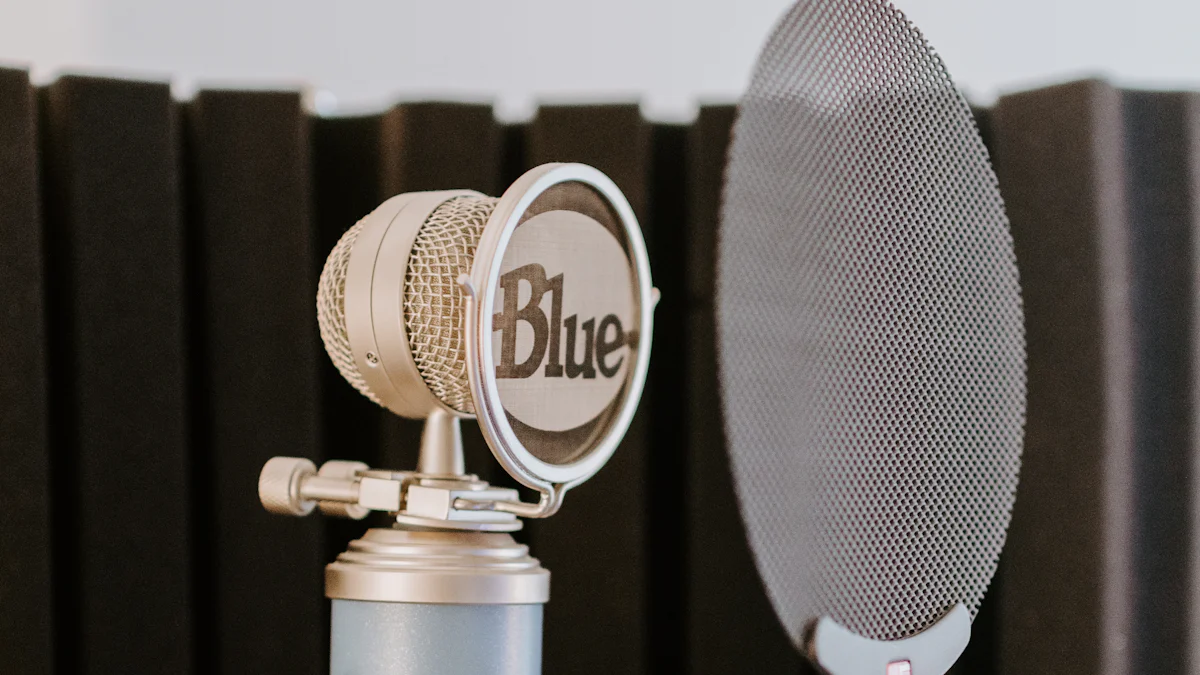Mastering Professional Sound on Zoom Calls

Sounding professional on Zoom calls is crucial for effective communication. When you speak clearly, you ensure your message reaches your audience without distortion. Poor audio quality can frustrate and disappoint participants, leading to ineffective meetings. Investing in a quality microphone with noise cancellation features can significantly enhance your audio clarity. This improvement not only boosts meeting outcomes but also elevates your professional image. Understanding how to sound professional on Zoom calls can transform your virtual interactions, making them more engaging and productive.
Key Takeaways
- Invest in quality audio equipment, such as Zoom Certified Headsets and USB microphones, to enhance your sound clarity and professional image during calls.
- Conduct pre-meeting sound checks using Zoom's built-in audio tests to identify and resolve any audio issues before your meeting starts.
- Minimize background noise by identifying common sources and using noise-canceling tools to maintain a distraction-free environment.
- Optimize your room acoustics with soft furnishings and acoustic panels to reduce echo and improve audio quality.
- Adjust your Zoom audio settings, including input and output volume, to ensure your voice is clear and balanced throughout the call.
- Utilize a teleprompter app to stay organized and maintain eye contact, enhancing your engagement and professionalism during meetings.
- Ensure good lighting by using natural light or affordable ring lights to improve your video quality and overall presence on Zoom calls.
How to Sound Professional on Zoom Calls
Choosing the Right Equipment
To sound professional on Zoom calls, selecting the right equipment is crucial. Your choice of audio gear can make a significant difference in how you are perceived during virtual meetings.
Headphones vs. Earbuds
When deciding between headphones and earbuds, consider comfort and sound quality. Zoom Certified Headsets offer enhanced audio quality and effective noise cancellation. They provide superior comfort for long meetings, making them an excellent choice for professional settings. Earbuds, while convenient, may not offer the same level of sound isolation or clarity. Investing in quality headphones can elevate your communication, ensuring you sound clear and professional.
Selecting a Quality Microphone
A good microphone is essential for clear communication. USB Microphones for Zoom Calls like the Blue Yeti, Shure MV5, and Samson Meteor Mic deliver professional sound quality. These microphones capture your voice with precision, reducing background noise and enhancing clarity. By choosing a high-quality microphone, you ensure your message is heard without distortion, making your Zoom calls more effective.
Importance of Audio Testing
Testing your audio setup before a meeting is vital. It helps you identify and resolve potential issues, ensuring you sound professional on Zoom calls.
Conducting Pre-Meeting Sound Checks
Before joining a call, conduct a sound check. Speak into your microphone and listen to the playback. This practice helps you adjust your equipment for optimal performance. Ensure your microphone is positioned correctly and your headphones are functioning well. Regular sound checks prevent technical glitches that could disrupt your professionalism.
Using Built-in Zoom Audio Tests
Zoom offers built-in audio tests to help you fine-tune your setup. Use these tests to adjust your microphone and speaker levels. The Zoom Noise Cancellation Feature can filter out background noise, enhancing your audio quality. By utilizing these tools, you ensure your voice remains clear and professional throughout the meeting.
Optimizing Your Environment

Creating a professional sound on Zoom calls involves more than just choosing the right equipment. Your environment plays a crucial role in how you are heard. By optimizing your surroundings, you can significantly enhance your audio quality and ensure clear communication.
Minimizing Background Noise
Background noise can be a major distraction during Zoom calls. Identifying and eliminating these noises will help you maintain a professional sound.
Identifying Common Noise Sources
Start by identifying common sources of noise in your environment. These might include:
- Appliances: Refrigerators, air conditioners, and fans can create a constant hum.
- Outdoor Sounds: Traffic, construction, or birds can seep into your space.
- Household Activities: Conversations, TV, or pets can disrupt your call.
Once you identify these sources, take steps to minimize their impact. Close windows, doors, and turn off unnecessary appliances during your calls.
Using Noise-Canceling Tools
Invest in noise-canceling tools to further reduce unwanted sounds. Noise-canceling headphones can block out ambient noise, allowing you to focus on the conversation. Additionally, consider using software solutions like Krisp or Zoom's built-in noise suppression feature to filter out background sounds. These tools ensure that your voice remains the focal point, enhancing your professional presence.
Reducing Echo and Reverberation
Echo and reverberation can make your voice sound distant and unclear. Addressing these issues will improve your audio clarity.
Adjusting Room Acoustics
Optimizing room acoustics is essential for reducing echo. Use room acoustic analyzers to evaluate your space's reverberation time and speech intelligibility. These tools help you make informed decisions about materials and design features that can improve sound quality. By reducing reverberation, you create a more comfortable and professional audio environment.
Using Soft Furnishings
Incorporate soft furnishings to absorb sound and reduce echo. Items like curtains, carpets, and cushions can significantly dampen sound reflections. Arrange these furnishings strategically around your room to create a more acoustically friendly space. This simple adjustment can make a noticeable difference in how you sound on Zoom calls.
By optimizing your environment, you enhance your ability to sound professional on Zoom calls. These adjustments not only improve audio quality but also contribute to a more productive and engaging virtual meeting experience.
Configuring Zoom Audio Settings

Fine-tuning your Zoom audio settings can significantly enhance your professional sound quality during calls. By adjusting these settings, you ensure that your voice is clear and impactful, making your virtual interactions more effective.
Adjusting Input and Output Volume
Properly setting your input and output volume is crucial for maintaining clear communication. This ensures that your voice is neither too loud nor too soft, providing a balanced audio experience for all participants.
Setting Optimal Levels
To set optimal levels, navigate to Zoom's audio settings. Here, you can adjust the input volume for your microphone and the output volume for your speakers or headphones. Aim for a level where your voice is clear without distortion. Speak into your microphone and watch the input level indicator. It should peak in the middle of the range. This balance prevents your voice from being too overpowering or too faint.
Troubleshooting Common Issues
If you encounter issues with your audio, start by checking your device's sound settings. Ensure that your microphone and speakers are selected as the default devices. If your voice sounds muffled or distorted, try repositioning your microphone or adjusting the input volume. For persistent issues, consider updating your audio drivers or restarting your device. These steps can resolve most common audio problems, ensuring you sound professional on Zoom calls.
Utilizing Original Sound
Zoom's Original Sound feature allows you to maintain the natural quality of your audio. This is particularly beneficial for musicians and presenters who require high-fidelity sound.
Enabling Original Sound in Zoom
To enable Original Sound, go to your Zoom settings and select the "Music and Professional Audio" section. Check the box for "Show in-meeting option to enable Original Sound." During a call, you can toggle this feature on to prevent Zoom from altering your audio. This setting preserves the natural quality of your voice, providing a more authentic listening experience.
Benefits of Original Sound for Musicians and Presenters
For musicians and presenters, Original Sound offers significant advantages. It maintains the integrity of musical tones and vocal nuances, which are often lost with standard audio processing. This feature ensures that your audience hears your performance or presentation as intended, enhancing their engagement and understanding. By utilizing Original Sound, you elevate your professional presence and deliver a superior audio experience.
By configuring your Zoom audio settings effectively, you enhance your ability to sound professional on Zoom calls. These adjustments not only improve your audio clarity but also contribute to more productive and engaging virtual meetings.
Maintaining Professionalism During Calls
Maintaining professionalism during Zoom calls involves more than just sounding good. You need to stay organized and present yourself well. Using a teleprompter app and ensuring good lighting can significantly enhance your professional image.
Using a Teleprompter App
A teleprompter app can be a game-changer for staying on track during your Zoom meetings. It helps you deliver your message clearly and confidently without losing your train of thought.
Benefits for Staying on Track
Teleprompter apps offer several advantages that help you maintain focus:
- Script Management: You can load and save scripts, ensuring you have all your notes ready.
- Eye Contact: By displaying your script near your camera, you maintain eye contact with your audience, enhancing engagement.
- Confidence Boost: Knowing your script is right in front of you reduces anxiety and boosts your confidence.
Recommended Apps
Consider these teleprompter apps to enhance your Zoom call experience:
- Prompt+ Teleprompter: This app offers advanced features like speed control and multilingual voice control. It's compatible with platforms like Zoom and Microsoft Teams, making it versatile for various virtual meetings.
- Teleprompter Pro: Known for its user-friendly interface, this app allows you to record using a webcam and mirror text for physical teleprompters. It integrates seamlessly with video conferencing tools, ensuring you stay on script while maintaining eye contact.
Ensuring Good Lighting
Good lighting is crucial for how you are perceived on Zoom calls. It affects both video and audio perception, contributing to a more professional appearance.
Impact on Video and Audio Perception
Proper lighting enhances your video quality, making you look more professional. It also affects how your audio is perceived. A well-lit face ensures that your expressions are visible, adding clarity to your communication. Poor lighting can cast shadows, making you appear less engaged and diminishing your professional presence.
Simple Lighting Solutions
You don't need expensive equipment to achieve good lighting. Here are some simple solutions:
- Natural Light: Position yourself facing a window to utilize natural light. It provides even illumination and enhances your appearance.
- Ring Lights: Affordable and effective, ring lights offer consistent lighting. Place one behind your camera to illuminate your face evenly.
- Desk Lamps: Use adjustable desk lamps to direct light towards your face. Avoid backlighting, which can create silhouettes and obscure your features.
By incorporating these strategies, you enhance your ability to sound and look professional on Zoom calls. These tools and techniques not only improve your communication but also elevate your overall virtual presence.
Advanced Tips for Enhanced Audio
Enhancing your audio quality on Zoom calls can elevate your professional presence. By investing in advanced tools and techniques, you can ensure that your voice is heard clearly and effectively. Here are some tips to take your audio to the next level.
Investing in Acoustic Panels
Acoustic panels can transform your home office into a professional sound environment. These panels absorb sound waves, reducing echo and reverberation. This creates a clearer and more focused audio experience for your Zoom calls.
Benefits for Home Offices
- Improved Sound Quality: Acoustic panels minimize unwanted noise and enhance speech clarity. This makes your voice sound more professional and engaging.
- Reduced Stress: A quieter environment can reduce stress levels, allowing you to focus better during meetings.
- Enhanced Productivity: With fewer distractions, you can communicate more effectively, leading to more productive virtual interactions.
Installation Tips
- Strategic Placement: Place panels on walls where sound reflections are most likely to occur. This includes behind your desk and on adjacent walls.
- Use Room Acoustic Analyzers: Tools like ODEON Room Acoustic Software can help you evaluate your space and determine the best locations for panels.
- Aesthetic Considerations: Choose panels that complement your room's decor. Many panels come in various colors and designs, allowing you to maintain a professional appearance.
Exploring Software Solutions
Software solutions can further enhance your audio quality by providing tools for sound processing and mixing. These solutions offer flexibility and control over your audio settings.
Audio Enhancement Software
- Acoustic Software: This software simulates room acoustics and helps you understand how sound behaves in your space. It provides tools for capturing and analyzing acoustic measurements, ensuring optimal sound quality.
- Noise Reduction Tools: Programs like Krisp can filter out background noise, making your voice the focal point of your Zoom calls.
Virtual Audio Mixers
- Customizable Audio Settings: Virtual audio mixers allow you to adjust your microphone and speaker settings in real-time. This ensures that your audio remains clear and balanced throughout your meetings.
- Integration with Zoom: Many mixers integrate seamlessly with Zoom, providing an easy way to enhance your audio without complicated setups.
By implementing these advanced tips, you can master how to sound professional on Zoom calls. Investing in acoustic panels and exploring software solutions will not only improve your audio quality but also enhance your overall virtual meeting experience.
Mastering how to sound professional on Zoom calls is essential for effective communication. By investing in quality equipment like Zoom Certified Headsets and high-quality USB microphones, you ensure superior audio clarity and reduce background noise. These tools, combined with Zoom's noise cancellation feature, create a clear and professional sound environment. Implementing these strategies enhances your virtual interactions, making them more engaging and productive. Apply these tips to elevate your professional image and improve communication in every Zoom meeting.
FAQ
What are the optimal audio settings for different types of microphones?
To achieve the best sound quality, you should tailor your audio settings to your microphone type and environment. For headsets, set background noise suppression to low. For external USB podcast microphones, set it to high. Booking a test call can help you fine-tune these settings for your specific setup.
How can I improve my Zoom audio quality?
Enhancing your Zoom audio quality involves using high-quality audio devices like an external computer mic and an audio interface. Optimize Zoom's sound settings to match your devices. This approach ensures clear and professional sound during your meetings.
Why are audio settings important for optimal sound quality on Zoom?
Proper audio settings are crucial for clear and professional sound quality. This is especially important for music teachers, performers, and anyone sharing high-quality sound. Adjusting your settings ensures your audience hears you as intended.
What role does the recording environment play in microphone performance?
Your recording environment significantly impacts microphone performance. Choose a microphone based on your environment's noise level. Consider factors like sensitivity, noise rejection, and built-in filters to ensure optimal performance.
What audio interfaces are recommended for a better Zoom experience?
For a superior Zoom experience, especially in virtual sessions, consider using audio interfaces. These are particularly beneficial for music therapists who use multiple microphones for voice and instruments. They provide the best audio quality and flexibility.
What is recommended for improving audio quality on Zoom calls?
Avoid using desk stands for your microphone during Zoom calls. They can pick up unwanted sounds. Instead, use a pop filter and boom arm to enhance your microphone's performance and ensure clear audio.
Why is a solid microphone important for video conferencing?
Investing in a solid microphone is essential for video conferencing. It ensures high-quality sound, which is crucial for effective communication. USB microphones are recommended for their durability and suitability for podcasting and video calls.
What is essential for selecting the best headsets for Zoom meeting calls?
When choosing headsets for Zoom meetings, understand the options, special features, issues, and styles available. This knowledge helps you find the perfect audio solution that meets your needs and enhances your virtual communication.
See Also
Perfecting Your Skills for Effective Hybrid Zoom Meetings
12 Creative Zoom Backgrounds to Enhance Your Online Meetings
A Comprehensive Guide to Mastering Computer Audio Visuals
